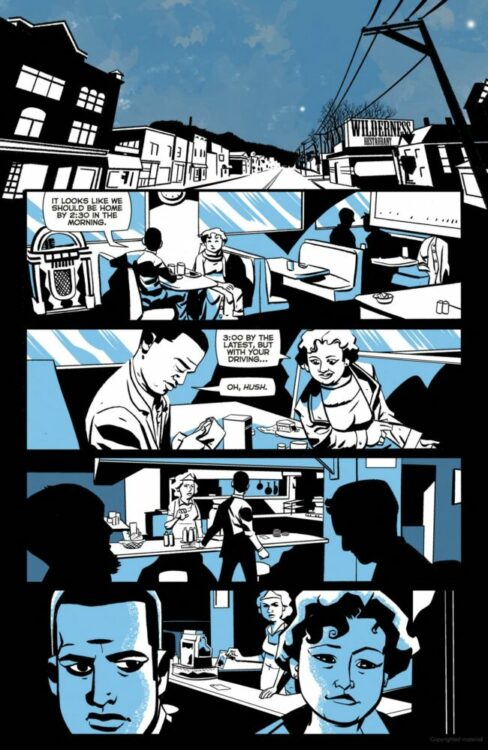From modern all-star writer James Tynion IV (Detective Comics; Something is Killing the Children) and acclaimed artist Michael Avon Oeming (Powers; Cave Carson) comes a tense and fascinating adaptation of a *possible* first-hand alien encounter in Blue Book: 1961. Featuring letters from Aditya Bidikar, this 6-issue mini-series chronicles the events and subsequent fallout of the infamous Hill abduction incident – an account that effectively started the modern interest in UFO’s. With a thoughtful, compelling script and atmospheric visuals, this is a must-read for true horror connoisseurs.
“In Blue Book, teaming with artist Michael Avon Oeming and letterer Aditya Bidikar, Tynion presents what he calls his “True Weird” stories. Tales of ordinary people encountering the strange and the impossible. Volume 1 retells the infamous case of the abduction of Betty and Barney Hill of New Hampshire in 1961–the very first widely-publicized UFO abduction that went on to shape and influence all future encounter stories.”
Writing & Plot
James Tynion IV eschews much of his original writing style to create a journalist-esque recounting here in Blue Book: 1961. Tynion calls this genre, the genre of potentially *real* cryptid encounters, “True Weird” tales. Much of the story is told in factual paragraphs. Instead of dialogue balloons, we get a lot of boxes. This document-style overhead narration of the Hill encounter works perfectly, as it feeds the reader context while building atmosphere and tension. There isn’t much dialogue, but what there is feels natural while fitting into the story’s tone. While the real Hill incident is still a mystery, Tynion does a great job taking the couple’s real testimony and adding his own takes on their narrative. There’s a phenomenal sequence between Betty Hill and one of the visitors where Tynion writes their hypothetical dialogue and it works beautifully. One of the most impressive elements of Tynion’s comic writing is that he clearly understands how to leverage the visual medium. Large chunks of the story are told through silent sequential storytelling that adds both tension and mystery to this deeply fascinating sci-fi tale. Overall, Tynion does an incredible job of adapting this account from numerous sources and turning it all into a comic script.
Art Direction
The real storytelling draw for Blue Book: 1961 is the visual work of comics veteran Michael Avon Oeming. His unmistakable style fits perfectly into the mysterious narrative Tynion scripts based on these alien encounters. While Oeming’s pencils are of course distinct and impressive, it’s his use of color that is the real star here. His super-thin pencils work to create his usual unique style of character design, and allow for his dense color art to dominate the book’s aesthetic. The entire mini-series consists of only a few colors – black, white, and several shades of dark blue. The story takes place almost entirely at night or in dark offices, so Oeming’s color choice makes sense – but it’s his utilization of these colors that makes this book so special. The hill driving through the black and blue night as they’re suddenly blasted by the bright lights of a spaceship absolutely explodes off of the page. There’s a dreamlike sensibility to many of the scenes as the Hill’s process what has happened to them, and Oeming’s color art really carries that notion. The deep, eerie tone pulls readers into this thriller, but it avoids feeling entirely like a horror story. The Hill Incident as told by Oeming and Tynion is certainly an unnerving event, and this comic has its terror-filled moments, but much of the story is filled with a sense of wonder. Oeming’s sequential direction carries the story on with an eye for capturing moments that will stick with readers long after they’ve closed the book. The initial encounter is a masterwork of visual tension, with Hill’s nice vacation drive growing in terror and intensity as their alien visitors encroach ever closer. There’s a moment later in the book involving Betty and a compass that still sticks in my mind as a brilliant piece of quiet study. Oeming uses a grid-style page to show Betty piecing together parts of the night and the after-effects of their abduction. Aditya Bidikar finishes the book off with his expertly handled lettering. His fonts are easy to read and shift naturally with the tone of dialogue. The narration text mimics a typewriter font, and the actual style of the dialogue lettering has a distinctly classic appearance. This approach furthers the aesthetic of decades past, perfecting an already outstanding visual experience. Overall, the visual direction in this comic is a phenomenal work of atmospherically complex visual direction.
Verdict
Blue Book: 1961 is a fantastically original adaptation. James Tynion takes what is one of the most famous incidents in the world of “real” alien encounters and turns it into a series of tense, compelling scripts that do justice to the original account while creating a stellar narrative. The visuals from Michael Avon Oeming bring home the unique atmosphere of the comic with a simplistic yet deceptively complex use of color and his unmistakable style. The only problem with this collected edition? It lacks the great backup short stories that were featured at the end of every issue. If you’re a fan of strange tales of suspense, both real and fictional, then be sure to grab this collection when it hits shelves on September 19th!

